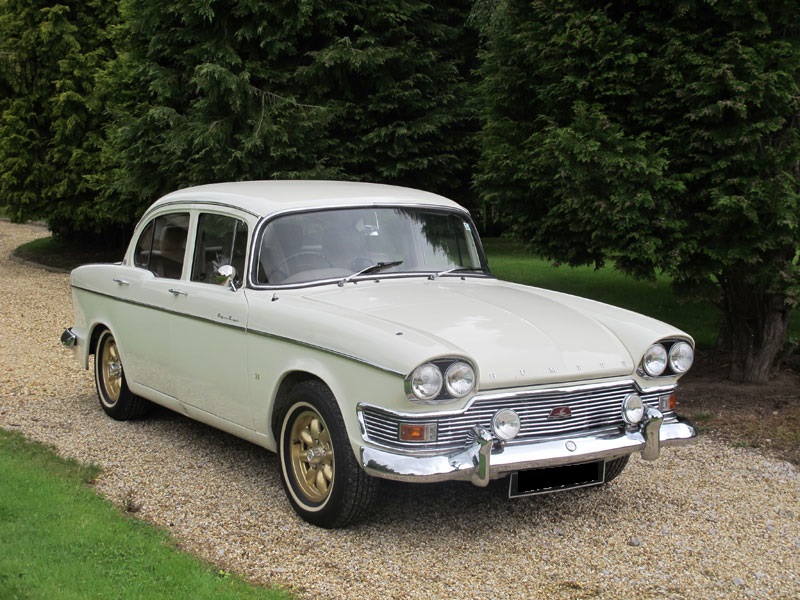-
Insurance
InsuranceAbout our productsLearn about insuringGet a quote Get current values, historical values, model history and more.
-
Valuation
ValuationHagerty valuation toolLook up a vehicle value Get current values, historical values, model history and more.
-
Events
EventsHagerty official eventsHagerty ClubhouseEvent calendar
-
Entertainment
EntertainmentMore to explore
- Portal login
1950 Humber Super Snipe
III 4dr Saloon 4.1 L
Vehicle values by condition
Fair
Condition 4
£4,400
#4 cars are daily drivers, with flaws visible to the naked eye. The chrome might have pitting or scratches, the windshield might be chipped.
Good
Condition 3
£8,100
#3 cars could possess some, but not all of the issues of a #4 car, but they will be balanced by other factors such as a fresh paint job or a new, correct interior.
Excellent
Condition 2
£9,800
#2 cars could win a local or regional show. They can be former #1 cars that have been driven or have aged. Seasoned observers will have to look closely for flaws.
Concours
Condition 1
£12,100
#1 vehicles are the best in the world. The visual image is of the best car, unmodified, in the right colours, driving onto the lawn at the finest concours.
Insurance premium for a
1950 Humber Super Snipe III 4dr Saloon 4086
valued at £8,100
£107.72
/ year*
History of the 1950 - 1952 Humber Super Snipe

1950 - 1952 Humber Super Snipe
The Humber Super Snipe is a formal six-seat, rear-wheel-drive saloon with a 4.1-litre OHV I-6 engine that was beloved of government departments, police forces and provincial mayors. The suspension is independent via transverse leafs at the front with semi-elliptic rear springs and an anti-roll bar and the formal coachwork was mounted on a stout chassis.
Humber launched the original Super Snipe in 1938, and it was made in small numbers during the Second World War for the armed forces. Civilian market models were re-available in 1946 and retrospectively known as the ‘Mk I’. In September 1948 the Super Snipe was extensively revised as the Mk II. The car's overall length was extended by seven inches, a new Raymond Lowey-styled front end gave the big Humber a family resemblance to its Hawk Mk III stablemate, and a wider track made the Mk II a genuine six-seater with leather trimmed benches fore and aft. The body sported running boards and the standard equipment list included a sliding roof and a rug rail for the back seat passengers. A ‘Synchromatic’ steering column gear lever replaced the earlier floor change.
In 1949, the circular front fog/pass lamp system was replaced by rectangular side lamps and alternative body styles included a ‘touring limousine’, an estate car and, possibly the most attractive of all, the Super Snipe convertible that was available until 1950. Some 125 chassis were despatched from Coventry to Tickford of Newport Pagnell and the resulting drophead was expensive - £1,992 12s 2d.- but exceptionally handsome.
The Mk II Super Snipe was built until August 1950 when the Rootes Group launched the Mk III, which was three inches longer and fitted with a Panhard rod for the rear suspension. There were also spats over the back wheels and foot treads made from stainless steel for the running boards. The price was £1,471 and production ran until October 1952 when the Mk III was succeeded by the very different Mk IV.
The basic engine unit for the Mk II and the Mk III Super Snipe was Humber’s 4086cc side-valve unit and the transmission was an all-synchromesh 4-speed box. The Humber was very well regarded for their durability – a Mk II came second in the 1950 Monte Carlo Rally – and their ability to cope with the worst of British roads. A modern driver will inevitably appreciate that these Super Snipes predate PAS and the sheer weight of the body does mean that the Super Snipe inevitably oversteers. That said, the engine is very flexible – it was designed for a car that would often take part in civic parades – and rear seat passengers will certainly enjoy their gracious surroundings.
With regard to potential restoration issues, the engines are famously robust but a poor interior could cost you a great deal of money to restore. For body parts, trim and general advice, there is the excellent ad supportive Post Vintage Humber Car Club
The Super Snipe Mk II and Mk III are prime examples of why the Humber marque was so respected around the globe – dignified but never pompous and built for the keen owner driver as much as his/her chauffer.
A Mk II or III Humber Super Snipe owner would have also been in the market for the smaller but equally distinguished Wolseley 6/80, the Austin 125 Sheerline, or the Ford V8 Pilot.
All 1950 Humber Super Snipe body types
| Year | Make | Model | Submodel | Body Type | Engine size | Average value |
|---|---|---|---|---|---|---|
| 1948 | Humber | Super Snipe | II | 4dr Saloon | 4.1 L | £ 4,500 8,300 9,900 12,200 |
| 1950 | Humber | Super Snipe | III | 4dr Saloon | 4.1 L | £ 4,400 8,100 9,800 12,100 |
Hagerty Newsletter
Get your weekly dose of car news from Hagerty UK in your inbox

ADVERTISEMENT